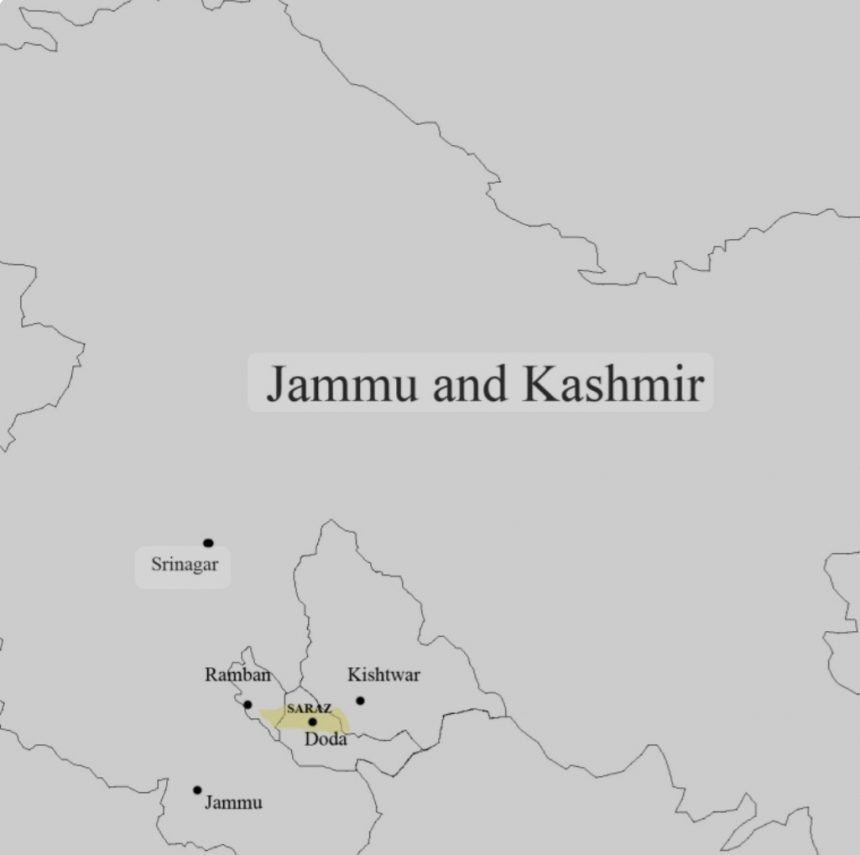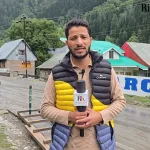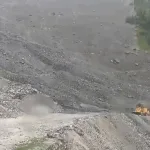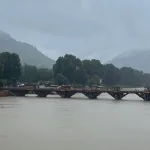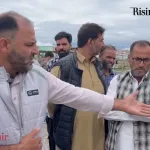Culture is the building block of any community or nation- state that blends the people in a single mosaic of continuity, yet imparting a distinct identity and inculcation of a feeling of exclusivity to our habitats. India with its diversities in all conceivable fields ranging from race, language, attire, looks and such like spread has been for centuries a nightmare for an anthropologist & a psephologist all the same. Since both of these experts do not have such a raft of terms of reference within which our country’s demographic diversity could be accommodated. Yet with such a stupendous spread of diversity in its being, India has been able to lug its identity in the comity of nations of this world with an ease that would make most homogenous countries of the planet cringe.
One such diversity that has been defining the northernmost UT of India, i.e. J&K lies nestled in the remote corner of Doda/ Kishtwar going by the name ‘Saraz’ or ‘Siraj’. This article of mine has been prompted primarily by the fact that an overwhelming numbers of this region collectively called as ‘Sarazies’ have displayed an abiding faith and trust in the democratic traditions of India by partaking in the election process that were just concluded recently. Moreover these ‘Sarazies’ have displayed a diverse attitude in selection of their public representative who is a Muslim from Doda and simultaneously a Hindu from Kishtwar, thus displaying their eruditeness in the so called ‘Dance of democracy’ i.e. elections.
The entire Jammu hills are a crucible of ethnic groups, encompassing people from diverse backgrounds with every few kilometers springing a surprise in the variety of local dialects, food, way of living and so on. As mentioned above, a particular ethnic group residing in the NE region of J&K is the ‘Sarazies of Saraz area. Basically hailing from ‘Kangra’ district of HP, this region has been relatively virgin in terms of exploration in fields like culture and heritage thereby posing danger to the individuality of the locals of this region. My primary source of information for this write up has been garnered from endless interviews and discussions on both the print and visual media that gained traction after the recently concluded assembly elections of J&K in which the public reps so chosen for this ‘Saraz ‘ region were from the AAP Party and BJP parties. A complete diametrically opposite set of parties.
In any case I am not going into the why & wherefores of such an election result from this area of ‘Saraz’. ‘Living a comfortable life has never been a priority; however living healthy has always been prioritized by us Sarazies’—A common refrain heard in the area of Saraz. This statement could be justified by having a look at the culture of the natives of Saraz. This area of Saraz is located on the right bank of River Chenab in Doda district of J&K.
Being a backward area its topography is equally tough, with every child born over here a born trekker or a mountaineer. Saraz starts from ‘Kontwara’ village and spreads westwards up to village Rajgarh of Ramban. Comprising a large area, the ‘Desanullah’ divides this area into two unequal halves. This nullah joins Chenab few miles from Chapnari on Chenab’s right bank.The Gazetteer of Kashmir and Ladak( 1890 :755) describes this area as ‘the district lying on the west side of the province of Kishtwar . It is drained by the ‘Lidar Khol’ stream and traversed by the path leading from Doda to BrariBal’.
Historically, Saraz was a pargana, an administrative unit for revenue under the Mughals of Kishtwar province that had so many feudal lords which derived its name from ‘Sau Raje’ meaning hundred feudal lords. Over time this moniker of ‘Sau Raje’ got tongue twisted into the present name of ‘Saraz’ and has remained so, but with a major difference which went by the commonality of the language ‘Sarazi’ thus diffusing the 100 feudal lords’ concept in its entirety. These Sarazis have been lugging the mediaeval past of their existence when they were forced to take refuge in the hills of HP & Jammu & Kashmir under the direct threat of ‘Muslim proselytization’ during the hey days of Mughal rule. Faced with threat to life and faith these hapless people chose going into the hills to help escape the wrath of their insolence and give the Muslims a fight at some later stage of their lives. No wonder in this community of Sarazis we will find Katochs from HP, Parihars from Patna & MP, Ranas & Rathores from Rajasthan, Manhas from Jammu, Kotwal from Kathua and so on.
The average life of a Sarazi is full of hard work and toil with the day starting at 4 am in the morning. Unbelievable, isn’t it? I am sure a family living in the metro of Mumbai and commuting daily for its job on the shuttle trains won’t be getting up so early. A Sarazi woman makes arrangements for huge joint family, pick up the spinning wheel from where it was left, clean the cow shed and offer grass to the cattle. The houses in Saraz region are generally kutcha made up of stone, wood, clay and Kashi or Zou(a species of grass) that are used for making roofs. In order to clean the walls of the house they mainly use white clay or ‘Maita’/ Maite prominently in the region, whereas from the inside these people use red clay or
‘Mausam mite’ that is found in abundance in the Saraz region.
In so far as decorations of these houses are concerned from the outside, black clay was used in an alternate manner with the white clay forming a horizontal stripe pattern. For cleaning the floor of the house cow dung was used and mixed with red clay as a coating. The brooms for the sweeping these floors are made of ‘Nelaou’ (a kind of grass) often used as a fodder for the cattle. As far as food and the kitchen of an average Sarazi is concerned, it is cooked more as a necessity rather than everything about taste; a need unlike us who crave everything about taste and colour to make it titillate our taste buds.
Since the area being tough and remote with shortages of essential commodities that goes to make a culinary experience truly memorable, the younger generation has introduced various innovations in the food that has led to the evolving of various varieties of the same. As a result out came favorite traditional dishes like ‘Ridiya’ (a vegetable dish), ‘Badi’(or Bari) , Latti etc. They also used to have chapattis made out of leaves of ‘Phagna’ ( a local tree found in the area) in their hard times for survival. ‘Chullah’ or a ‘Bakhari’ in local dialect were the kilns used to cook the food, and for an average Sarazi the ‘Noon-chai’ and ‘Makkiki roti’ in breakfast & Rajmash , potato , Kasrodh, wild mushroom, Kolth, Sadafali, lekhun cooked in buttermilk etc made up for the lunch.
The readers of this article must be wondering that with such a hazardous area to live in, what the Sarazis do in case of a medical emergency? Well, health has never been a trouble or impediment for leading a healthy life in these mountains for the Sarazis. It is the sheer simplicity of their lifestyles and a very rudimentary diet plan that lies at the center of their being up and about their daily routines day in and out unlike us city dwellers who despite gobbling up dozens of supplements are still worried sick of our health. Herbs and homemade medicines like the ‘Pit Papada or Nelod’ as it is locally called was used to treat headache, fever and in a grinded form given to the patients suffering from low appetite. ‘Charanathi’ herb is used for bloodshot eyes and also applied as ‘Kohl’ or ‘Surma’ to keep the eyes in a healthy condition. The seeds of ‘Popde’ or ‘Sadi’ (a variety of apricot) is used to treat boils. Similarly to relieve cracked heels, native people apply fat of bear or sheep. The list of homegrown curative properties of such native medicines is endless to be accommodated over here in this short article of mine in ‘Rising Kashmir’ paper.
As far as the language spoken in the area is concerned, Saraz is full of natives that speak Kashmiri, Kishtwari, Bhaderwahi, Pogli or Sarazi & Dogri. While Muslims have started identifying and claiming their language to be Kashmiri, Hindus continue identifying with local languages such as Kishtwari, Bhaderwahi, Sarazi or Pogli depending upon their location in the sub-region. In fact many natives of this area are polyglots, switching with an ease from Kashmiri to Bhaderwahi to Sarazi to Dogri. An amazing quality of integration of languages in this brutal area of J&K.
With the center of gravity of militancy suddenly shifting to this peaceful area of ‘Saraz’ from the Kashmir valley, Urdu language has been foisted upon the women folk of this area just to save their skin from harsh interrogation methods of the security forces who believe them to be the facilitators of these militants. Be that as it may, it is a sad reality of our present times that a cultural identity of this Muslim dominated erstwhile state (read Urdu language) which should have been a source of building bridges in this remote corner of J&K has made entry more as a source of compulsion borne out of militancy and less out of love for this lingua franca spanning a cross section of races and religions.
Now it goes to the chosen public representatives belonging from both the AAP party & BJP i.e. Mehraj Malik & Shagun Parihar to build bridges of confidence and good governance in their respective areas of Doda & Kishtwar having helmed the elections on the strength of their mandate. This is the least the people of Saraz can expect from their franchise. The sooner the better.
(The writer is a retired army officer and a regular scribe of Rising Kashmir. He can be approached on his email at: [email protected])


